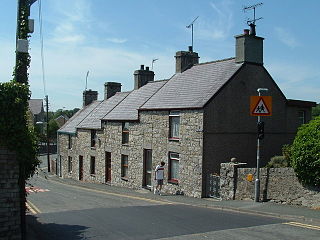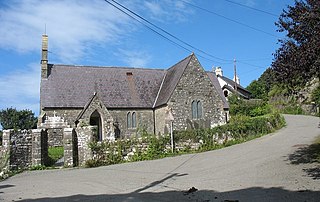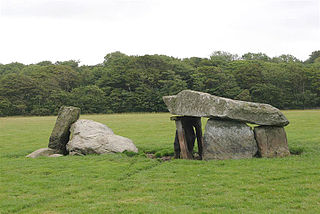
Bodedern is a village and community in the west of Anglesey, Wales. At the 2001 census, it had a population of 1,074, decreasing slightly to 1,051 at the 2011 census. The community includes the settlements of Llanllibio and Pen-llyn.

Pentraeth is a village and community on the island of Anglesey, North Wales, at grid reference SH523786. The Royal Mail postcode begins LL75. The community population taken at the 2011 census was 1,178. The village itself having a population of 557.

Moelfre ( ) is a village, a community and, until 2012, an electoral ward on the north-east coast of the Isle of Anglesey in Wales. The community area covers the village and harbour, and several smaller, dispersed settlements. It includes six scheduled Iron Age hut groups and many other sites of archaeological interest. The harbour was formerly a local fishing port; a lifeboat station has been based here since 1854. Among many shipwrecks off the coast was that of the Royal Charter in 1859. Near the modernised lifeboat station is the RNLI Seawatch Centre. The coastline includes a rocky headland north of the village and a large sandy beach at Lligwy Bay, both traversed by the Anglesey Coastal Path. The 2011 census measured the village population as 710. It was estimated at 614 in 2019.

A fishing weir, fish weir, fishgarth or kiddle is an obstruction placed in tidal waters, or wholly or partially across a river, to direct the passage of, or trap fish. A weir may be used to trap marine fish in the intertidal zone as the tide recedes, fish such as salmon as they attempt to swim upstream to breed in a river, or eels as they migrate downstream. Alternatively, fish weirs can be used to channel fish to a particular location, such as to a fish ladder. Weirs were traditionally built from wood or stones. The use of fishing weirs as fish traps probably dates back prior to the emergence of modern humans, and have since been used by many societies around the world.
Penmon is a promontory, village and ecclesiastical parish on the eastern tip of the Isle of Anglesey in Wales, about 3 miles (4.8 km) east of the town of Beaumaris. It is in the community of Llangoed. The name comes from Welsh: pen and Môn, which is the Welsh word for Anglesey. It is the site of a historic monastery and associated 12th-century church. Walls near the well next to the church may be part of the oldest remaining Christian building in Wales. Penmon also has an award-winning beach and the Anglesey Coastal Path follows its shores. Quarries in Penmon have provided stone for many important buildings and structures, including Birmingham Town Hall and the two bridges that cross the Menai Strait. The area is popular with locals and visitors alike for its monuments, tranquillity, bracing air and fine views of Snowdonia to the south across the Menai Strait.

Anglesey is an island off the north-west coast of Wales. It forms the bulk of the county known as the Isle of Anglesey, which also includes Holy Island and some islets and skerries. The county borders Gwynedd across the Menai Strait to the southeast, and is otherwise surrounded by the Irish Sea. Holyhead is the largest town, and the administrative centre is Llangefni. The county is part of the preserved county of Gwynedd. Anglesey is the northernmost county in Wales.

St Iestyn's Church, Llaniestyn is a medieval church in Llaniestyn, Anglesey, in Wales. A church is said to have been founded here by St Iestyn in the 7th century, with the earliest parts of the present building dating from the 12th century. The church was extended in the 14th century, with further changes over the coming years. It contains a 12th-century font and a 14th-century memorial stone to Iestyn, from the same workshop as the stone to St Pabo at St Pabo's Church, Llanbabo.

St Dona's Church, Llanddona ) is a small 19th-century parish church in the village of Llanddona, in Anglesey, north Wales. The first church on this site was built in 610. The present building on the site dates from 1873, and was designed by the rector at the time. It reuses earlier material including a decorated 15th-century doorway and a 17th-century bell.

Llaneilian is a village and community in Anglesey, Wales. It is located in the north east of the island, 2.2 miles (3.5 km) east of Amlwch, 16.5 miles (26.6 km) north west of Menai Bridge and 12.5 miles (20.1 km) north of Llangefni. The community includes the villages and hamlets of Dulas, Llaneilian, Pengorffwysfa, Cerrig Man and Penysarn, Gadfa and Nebo, and at the 2001 census had a population of 1,192, decreasing slightly to 1,186 at the 2011 Census. The parish is crowned by its hill, Mynydd Eilian, a HuMP, popular with walkers and ramblers, and its beach, Traeth Eilian, which is popular with holidaymakers and for watersport activities. At the north easternmost point is Point Lynas,, while Ynys Dulas lies off the North East coast of the island, east of Dulas Bay.

The Bryn Gwyn Stones or Bryn Gwyn Standing Stones are neolithic stones in Brynsiencyn on Anglesey.

Bwrdd Arthur, also known as Din Sylwy, is a 164-metre (538 ft) flat-topped limestone hill on the island of Anglesey, in Wales. Located on the eastern end of Red Wharf Bay, some 3 kilometres north west of Llangoed, it is noteworthy from the evidence of pre-historic occupation and as a Site of Special Scientific Interest designated for its botanical interest.

Gwynedd is a large rural county in North Wales. The northern half includes the high mountains of Snowdonia and the mixed farmland and hills of the Llŷn peninsula, which between them make up much of the former county of Caernarfonshire. The southern part of Gwynedd is the softer coastal and upland landscapes of the former county of Merionethshire. Gwynedd, the second-largest county in Wales, has a total of 497 scheduled monuments. That is too many to have on a single list article, so for convenience the list is divided into three. The 365 prehistoric sites are in two lists, covering 171 sites in former Merionethshire, and 194 sites in former Caernarvonshire. The 132 sites dating from Roman to modern times are included in a single list covering the whole of the county. Gwynedd is a unitary authority comprising most of the two historic counties. In 1974 it also merged with Anglesey, and the merged county was also called Gwynedd. Since 1996 Anglesey has been a separate county again.

Presaddfed Burial Chamber is a listed monument in Anglesey, north Wales, comprising two Neolithic chamber tombs. It is a scheduled ancient monument and is located a short distance northwest of Bodedern. It is maintained by Cadw.

Din Dryfol is a Neolithic burial chamber on Anglesey, in Wales. It is a scheduled monument and is maintained by Cadw. The monument is near Bethel. Three phases of use have been identified, all dating from the Neolithic period.

Parciau hill fort is a hill fort on the Welsh island of Anglesey. It stands on the summit of Bryn Ddiôl, whose name means "trackless hill".

St Gwenfaen's Well is an early medieval holy well in the south west of Holy Island, Anglesey, named after St Gwenfaen, whose cloister was nearby. The site includes substantial remains of a building and is both a scheduled monument and a Grade II listed building. Traditionally, a gift of two white quartz pebbles thrown into the pool can cure mental health problems.

The Menai Strait fish weirs are historically important fishing traps used in the fast-flowing tidal waters of the Menai Strait, which separates Anglesey from the rest of North Wales. The strait was particularly well suited to utilising fish weirs. The tidal waters pull huge volumes of water past the coastline with every tide, and the weirs and traps enabled fish to be concentrated into small holding areas from which they can be readily caught. Such methods are thought to have been used from earliest times, but the submerged and standing remains along both the Anglesey and Gwynedd coasts are from medieval and post-medieval periods, and in some cases were still in use into the 20th century.

Porth Wen Brickworks first built by Charles E Tidy, is now a disused Victorian brickworks which produced fire bricks, made from quartzite (silica) used to line steel-making furnaces. The substantial remains include a number of buildings and the remains of some of the machinery, but has some damage from sea erosion. The site is a scheduled monument.


















